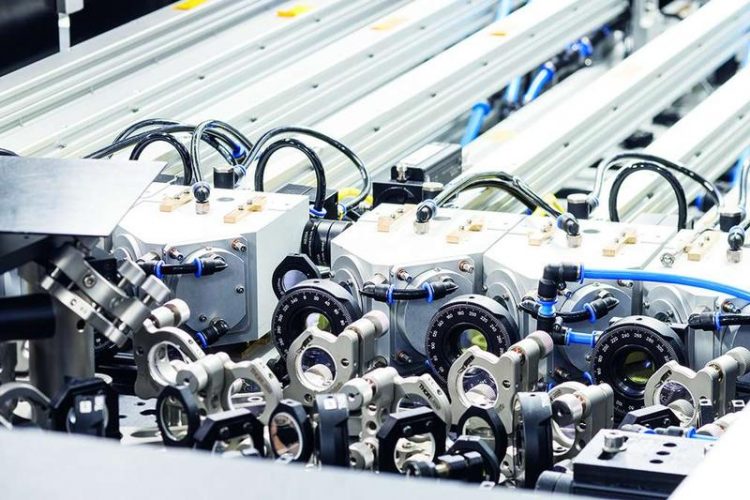Fraunhofer Develops New Generation of Lasers

Coherently combined USP fiber lasers of the kW class, as they are made available in the user facility at Fraunhofer IOF. © Fraunhofer IOF, Jena, Germany.
The kick-off event on May 2, 2018 in Aachen marks the beginning of an extraordinary venture. Prof. Reinhart Poprawe, head of the Fraunhofer Institute for Laser Technology ILT, announced together with Prof. Andreas Tünnermann, head of the Fraunhofer Institute for Applied Optics and Precision Engineering IOF, the launch of the Fraunhofer Cluster of Excellence “ADVANCED PHOTON SOURCES”.
“With twelve institutes, we are stepping up to the challenge of developing a new laser generation and demonstrating applications for industry and research. Together we target the development of a disruptive technology that will help expanding the applications for laser technology significantly – from the scaling of ultraprecise manufacturing processes to the development of new pulse duration and wavelength ranges for research,” said the director of the cluster, Prof. Poprawe.
What can USP lasers do?
Even at comparatively small pulse energies, USP lasers generate extremely high intensities in their focus. For a long time, they were only used in basic research. With the development of high-efficiency, high-performance pump diodes, new laser media could be used, in particular ytterbium-doped fibers and crystals. In recent years, USP lasers have achieved sufficient average laser power and robustness for enabling industrial applications.
For applications in micromachining, USP lasers have two major advantages: first, they can process virtually all materials; second, their ablation is particularly precise and, therefore, gentle since the ultrafast interaction hardly leaves any heat in the adjacent material. For these reasons, USP lasers were of interest to medical technologies from the beginning, e. g. for eye surgery using the Femto-Lasik technology.
“ADVANCED PHOTON SOURCES” user facility with two application laboratories will start in 2018
For cutting of ultra-hard ceramic materials and fiber-reinforced plastics, the performance of current 100 W class USP lasers is often insufficient in terms of economical processing speeds. Driven by the application potential in the industry and the need for basic research, the “ADVANCED PHOTON SOURCES” partners have set themselves the goal of increasing the average power of the USP sources at the Fraunhofer Institutes ILT and IOF up to the 10 kW range. With a budget of about 10 million euros for the first three years, the partners will develop and test beam sources for various applications.
In 2018, application laboratories will be set up at the two institutes. The development of system technology and innovative applications is enabled from an early stage. The Fraunhofer Cluster, which was founded at the beginning of the year, is open to all Fraunhofer Institutes. Currently twelve partners form the consortium: beside Fraunhofer ILT and IOF, the Fraunhofer Institutes FEP, IAF, IIS, IKTS, IMWS, ISE, ISIT, ITWM, IWM and IWS are involved.
The consortium aims at developing applications, investigating new processes and facilitating industrially relevant throughputs of well-known processes. Examples range from the micro-structuring and surface functionalization of solar cells, ultra-hard ceramics and battery components to the cutting of glass and lightweight materials.
In addition to achieving breakthroughs in ultraprecise manufacturing with high productivity, the partners also plan to generate coherent radiation down to the soft X-ray range – with photon fluxes two to three orders of magnitude higher than those previously reached. In the field of materials science, the Fraunhofer Cluster aims to establish applications such as the generation and investigation of novel materials. Moreover, new opportunities will arise for imaging biological samples or in the semiconductor field as well as for lithography.
The new lasers are also interesting for basic research: As an example, laser particle accelerators are more powerful, much smaller than conventional systems, and can even be integrated into existing laboratories. Furthermore, these so-called “secondary sources” can also significantly boost areas such as materials research and medical technology.
The synergies between the Fraunhofer Institutes enable the development of beam sources, process technology and innovative applications at a top international level. These can be made available for industry and research. As such high-power USP lasers become available, the research partners can revolutionize the innovation process in the technological environment of high-power lasers.
Contact
Dipl.-Ing. Hans-Dieter Hoffmann
Head of the Competence Area Laser and Optics
Telephone +49 241 8906-206
hansdieter.hoffmann@ilt.fraunhofer.de
Fraunhofer Institute for Laser Technology ILT
Steinbachstraße 15
52074 Aachen, Germany
Prof. Jens Limpert
Head of Department Fiber and Waveguide Lasers
Telephone +49 3641 947-811
jens.limpert@iof.fraunhofer.de
Fraunhofer Institute for Applied Optics and Precision Engineering IOF
Albert-Einstein-Str. 7
07745 Jena, Germany
http://www.ilt.fraunhofer.de/en
http://www.iof.fraunhofer.de/en
Media Contact
All latest news from the category: Physics and Astronomy
This area deals with the fundamental laws and building blocks of nature and how they interact, the properties and the behavior of matter, and research into space and time and their structures.
innovations-report provides in-depth reports and articles on subjects such as astrophysics, laser technologies, nuclear, quantum, particle and solid-state physics, nanotechnologies, planetary research and findings (Mars, Venus) and developments related to the Hubble Telescope.
Newest articles

Properties of new materials for microchips
… can now be measured well. Reseachers of Delft University of Technology demonstrated measuring performance properties of ultrathin silicon membranes. Making ever smaller and more powerful chips requires new ultrathin…

Floating solar’s potential
… to support sustainable development by addressing climate, water, and energy goals holistically. A new study published this week in Nature Energy raises the potential for floating solar photovoltaics (FPV)…

Skyrmions move at record speeds
… a step towards the computing of the future. An international research team led by scientists from the CNRS1 has discovered that the magnetic nanobubbles2 known as skyrmions can be…





















